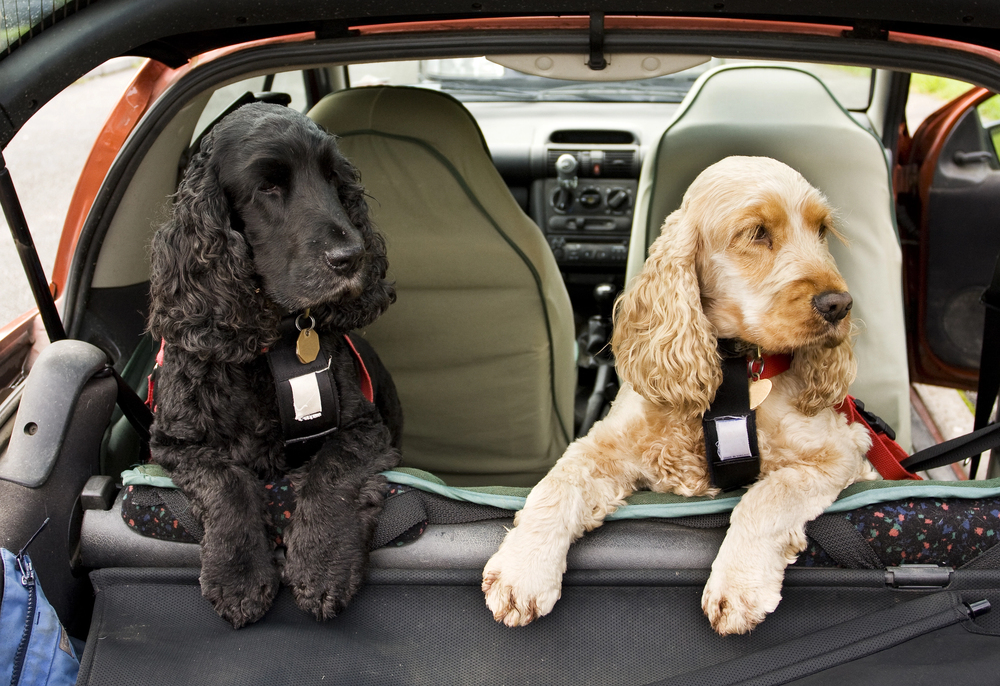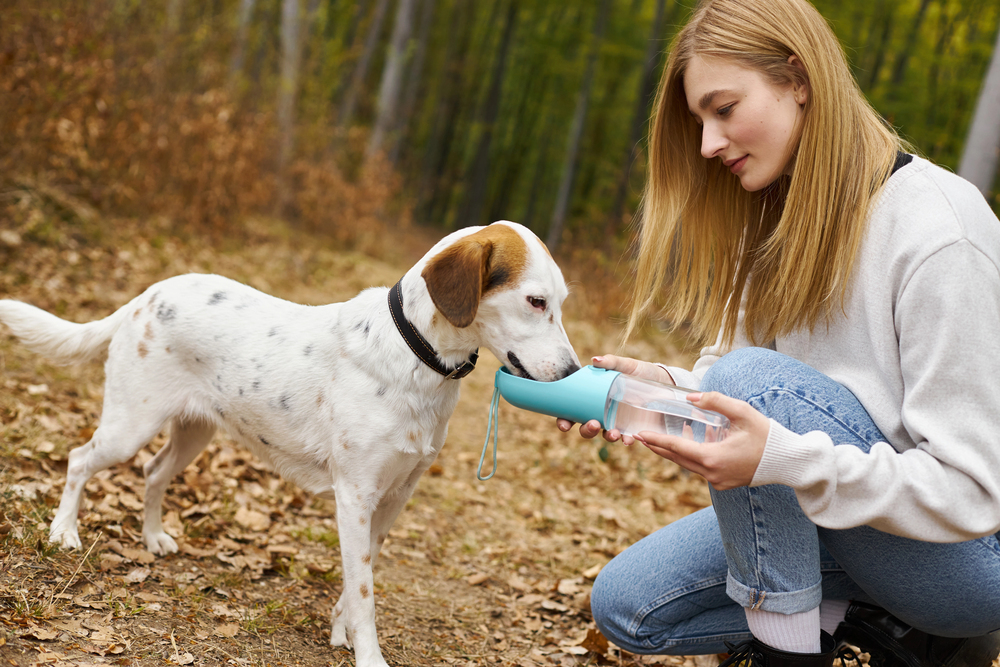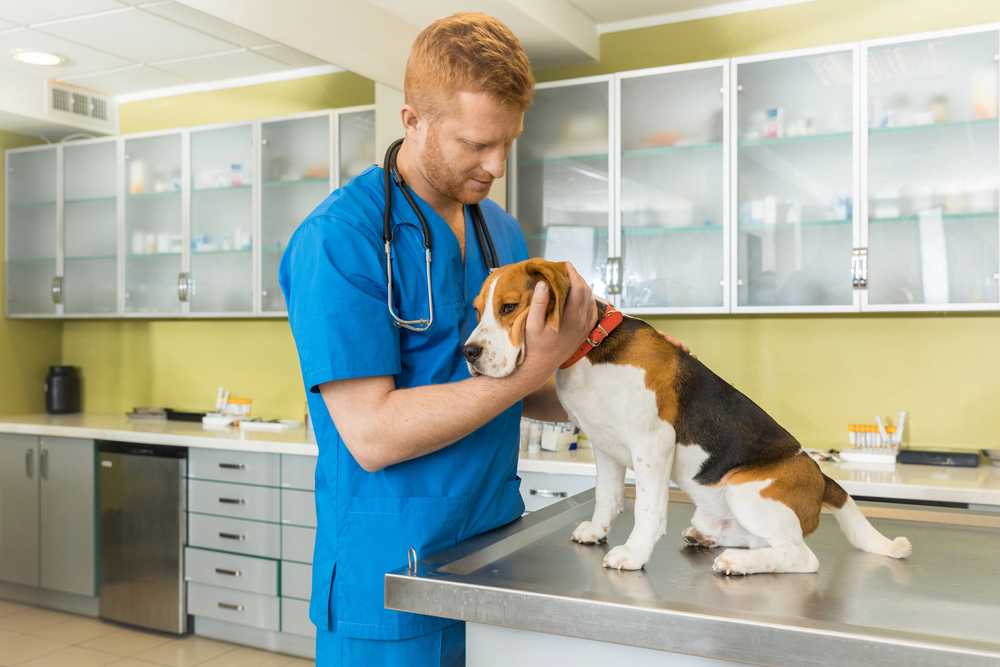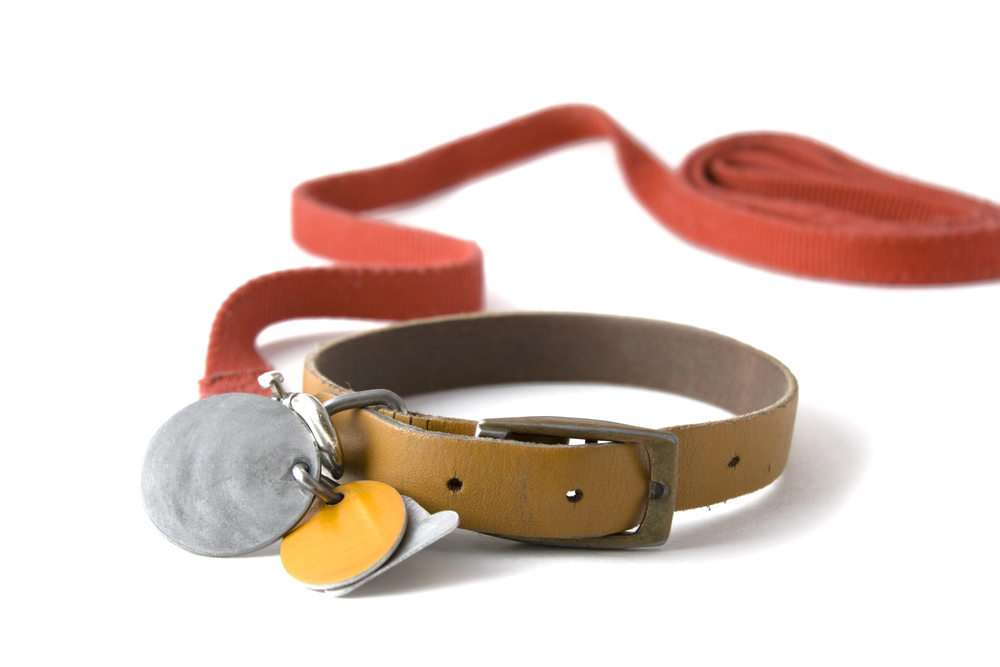
Book a vet appointment before you travel
Read Time: 10 minutes
Whether you’re hitting the road for a weekend getaway or embarking on a cross-country adventure, traveling with pets can be incredibly rewarding—but it also requires extra planning, especially when it comes to emergency preparedness. From medical needs to natural disasters, here’s how to make sure you and your furry friend are ready for the unexpected.
#1
Pack a Pet Emergency Kit
Emergencies are unpredictable, so having a ready-to-go pet emergency kit is essential. Organize your kit into categories to make it easy to use during stressful situations. Store all items in a durable, waterproof container that’s clearly labeled and easy to access on the road.
First-Aid Supplies: Tools To Treat Minor Injuries Quickly
- Gauze rolls and non-stick bandages
- Adhesive tape for securing dressings
- Antiseptic wipes or spray (pet-safe only)
- Tweezers for removing splinters or ticks
- Blunt-tipped scissors
- Cotton balls and swabs
- Saline solution for cleaning wounds or eyes
- Styptic powder (to stop minor bleeding)
- Digital thermometer (rectal) and water-based lubricant
- Disposable gloves
- Muzzle (even calm pets may bite when in pain)
Medications and Medical Records: Be Ready for Health Issues
- At least 7 days’ supply of any current medications
- Backup doses of preventatives (flea/tick, heartworm)
- Copies of veterinary records and vaccination certificates
- Written instructions for dosage and frequency
- Emergency contact card for your vet and an emergency vet along your route
- Medical history notes (chronic conditions, allergies, past surgeries)
Food and Water: Sustenance to Last at Least 3 Days
- 3–7 days’ worth of your pet’s regular food (dry or canned)
- Manual can opener (if using canned food)
- Collapsible food and water bowls
- Bottled water (enough for pet and human use)
- Portable water filter or purification tablets (optional but useful)

Identification and Documentation: Help Reunite You If Separated
- Current photo of your pet (print and digital)
- ID tags with up-to-date phone number
- Microchip number and registry info
- Temporary travel tag with your destination and cell number
- List of local shelters or animal control offices along your route
Comfort Items: Keep Stress Levels Low
- Blanket or towel that smells like home
- Favorite toy or chew item
- Extra leash and harness
- Crate or carrier with padding
- Calming spray or diffuser (pheromone-based)
- Pet anxiety vest (if your pet uses one)

Clean-Up Supplies: Maintain Hygiene on the Road
- Waste bags or litter and disposable trays
- Paper towels and disinfectant wipes
- Pet-safe cleaner for accidents
- Trash bags
- Extra towels and plastic sheeting
- Travel brush or grooming tool
Lighting and Tools: Be Ready After Dark or in Hazardous Conditions
- Flashlight or headlamp
- Extra batteries
- Reflective pet vest or collar
- Glowstick or clip-on LED light for leash
- Multi-tool (with knife, bottle opener, etc.)
#2
Research Pet-Friendly Emergency Services Along Your Route
In an emergency, every second counts. That’s why it’s crucial to identify pet-friendly emergency services before you even leave your driveway. With a little research and planning, you can travel confidently knowing help is never too far away.

Veterinary Services: Map Out Emergency and 24-Hour Clinics
What to look for: Not all towns have 24-hour veterinary care, so plan ahead by noting emergency clinics near your overnight stops and along less-populated stretches of road.
- Use apps like VetFinder, PetDesk, or Google Maps to search for terms like “emergency vet” or “24-hour animal hospital.”
- Confirm hours of operation and whether walk-ins are accepted.
- Save addresses, phone numbers, and directions in both digital and printed formats.
Pro tip
Program clinic contacts into your phone favorites list under a label like “Pet ER – [City].
Pet-Friendly Lodging: Know Where You Can Shelter With Your Pet
Why it matters: If you’re forced to reroute, evacuate, or deal with a breakdown, you’ll need a safe place where your pet is welcome.
- Look for hotels, motels, and campgrounds that allow pets.
- Websites like BringFido.com, PetsWelcome.com, and Airbnb filters make it easy to find pet-friendly stays.
- Pay attention to pet size/breed restrictions and nightly fees or deposits.
- Save a list of 2–3 backup options for each area you’ll pass through.
Bonus tip
Call the hotel in advance to verify their pet policy, even if it’s listed online—policies can change without notice.
Shelters and Evacuation Zones: Prepare for Regional Risks
Especially important: If you’re traveling through hurricane- or wildfire-prone areas, know which emergency shelters accept pets.
- Many public shelters do not allow animals unless they are registered service animals.
- Contact local emergency management offices to request a list of designated pet-friendly shelters.
- Check if you need to provide your own crate, vaccination records, or food for your pet.
Helpful resources
FEMA, ASPCA, and Red Cross often publish up-to-date lists and tips on emergency sheltering with pets.
Mobile Veterinary Units and Telehealth Options
In case of remote travel: Mobile vet clinics and pet telehealth services can provide quick consultation when brick-and-mortar options are limited.
- Look for mobile veterinary services that might be operating near rural towns, parks, or festivals.
- Sign up for pet telehealth platforms like Fuzzy, Pawp, or AirVet, which allow you to video chat with licensed vets and get advice, prescriptions, or peace of mind.
Pet Poison Control and Emergency Hotlines
Keep numbers handy: Immediate access to expert advice can be life-saving in cases of poisoning or distress.
- ASPCA Animal Poison Control: (888) 426-4435 (may charge a fee)
- Pet Poison Helpline: (855) 764-7661
- Local emergency animal services (add based on your travel states)
- Your pet’s primary veterinarian
Store these numbers in your phone and write them on an index card in your emergency kit.
#3
Update Tags, Microchips, and Travel ID
One of the most common dangers during pet travel is separation. A frightened animal can bolt during a rest stop, an accident, or a hotel check-in—and if they aren’t properly identified, your chances of being reunited drop significantly. Ensuring your pet’s ID is current and travel-appropriate is a small step that can make a big difference.
Collar ID Tags: Your First Line of Defense
Why it matters: If someone finds your pet, the ID tag is the fastest way for them to contact you.
- Make sure your pet wears a sturdy collar with a legible, up-to-date ID tag at all times while traveling.
- Include your current mobile phone number—not a landline, and not a number you can’t access on the road.
- If you’re staying in one location for several days, consider adding a temporary tag that includes your destination (e.g., “Staying at Pine Woods Cabin, Asheville, NC, June 21–25”).
- Use tags made of durable materials (like stainless steel or silicone) and check for signs of wear or fading before you depart.

Microchips: Permanent, Secure, and Often Overlooked
Why it matters: Collars and tags can fall off—but a microchip stays with your pet for life.
- If your pet is already microchipped, log into the registry (such as HomeAgain, PetLink, or AKC Reunite) and confirm that your contact info is accurate.
- Include an emergency contact who is not traveling with you (in case you lose access to your phone or email).
- If your pet isn’t microchipped yet, talk to your vet—it’s a quick and affordable procedure with long-term benefits.
- Carry a copy of your pet’s microchip number and registry provider in your emergency kit and on your phone.
Travel-Specific Identification: Smart Tags and QR Codes
Why it matters: Technology can help good Samaritans reunite you faster.
- Consider using smart pet ID tags that use QR codes or NFC chips. When scanned, they link to a profile with your contact info, vet details, and even medical notes.
- Examples include tags from platforms like PetHub, Dynotag, or Pawscout.
- Some GPS collars and tracking tags (like AirTags or Fi Smart Collars) offer real-time location tracking, which can be especially helpful during outdoor adventures or rest stop breaks.
Backup Identification: Always Have Redundancy
Because you never know:
- Pack a recent printed photo of your pet (from multiple angles if possible) to share if they go missing.
- Save several digital photos on your phone, ideally showing your pet with you to prove ownership.
- Create a short physical description (breed, color, size, identifying marks) and have it saved in a notes app or hard copy.
- Include your pet’s ID and medical information in a laminated card stored in your glove compartment or travel binder.
#4
Understand Local Weather and Natural Hazards
Different regions present different risks, and weather emergencies can escalate quickly—especially when you’re far from home. Taking time to understand the conditions you’ll encounter helps you avoid danger and adapt your plans on the go.
Check the Weather Daily While Traveling
Why it matters: Conditions can shift dramatically during multi-day trips.
- Use apps like Weather.com, AccuWeather, or NOAA for real-time alerts.
- Check both forecasted weather and severe weather advisories for your route and destination.
- Look out for heat advisories, winter storms, heavy rain, and high winds—all of which can affect travel safety for you and your pet.
Know the Regional Risks Before You Arrive
Each area comes with its own set of natural hazards:
- Hurricanes: Common in coastal regions—especially the Gulf and Atlantic during summer and fall.
- Wildfires: A risk in dry, mountainous, or forested areas like California and Colorado.
- Flooding: Can happen anywhere, but especially in low-lying zones or near rivers.
- Blizzards and Ice Storms: Common in northern areas or at elevation during winter.
- Tornadoes: Most frequent in the Midwest and South during spring and summer.
Research how to respond to local hazards before you leave—and prepare accordingly.
Adjust Travel and Rest Stops for Safety
- Avoid walking pets during lightning storms, extreme heat, or heavy snow.
- Always have shade or shelter nearby if traveling in hot climates.
- Never leave pets in a parked vehicle, even briefly—temperatures inside can spike to dangerous levels in minutes.
#5
Restrain and Secure Pets Properly
Pets need protection in transit just like people do. An unrestrained pet can be injured, become a distraction to the driver, or bolt in fear after a collision or sudden stop.
Use Crash-Tested Travel Restraints
Your options include:
- Harness seat belts that attach to car seat belts
- Travel crates or carriers secured to the backseat or cargo area
- Pet booster seats with tethers (best for small dogs)
- Barrier guards to keep pets in the back of an SUV
Avoid allowing pets to roam freely, sit on laps, or hang out of windows.
Make Sure Restraints Fit Properly
- Choose a harness designed for vehicle use (not just walks).
- Crates should be big enough for your pet to stand, turn around, and lie down—but snug enough to keep them stable in transit.
- Secure crates with bungee cords, seat belts, or tie-downs to prevent shifting during travel.
Practice Before a Long Trip
If your pet isn’t used to riding restrained, take short drives first to help them get comfortable. Reward calm behavior and increase the trip length gradually.
#6
Have a Plan for Evacuations or Breakdowns
Being stranded or forced to evacuate is stressful enough—imagine doing it without a plan for your pet. Advance planning turns chaos into a manageable situation.
Know Where You Can Shelter With Your Pet
- Keep a list of pet-friendly hotels, motels, and shelters along your route.
- Apps like BringFido and AllStays can help you filter for pet-friendly emergency lodging.
- Know the nearest emergency shelters that allow pets in any high-risk areas you’re passing through.
Prep a Breakdown Protocol
Be ready to respond if your car stops running:
- Have roadside assistance coverage that includes animal-safe towing if possible.
- Keep extra blankets, water, and a flashlight in case you’re stranded overnight.
- If temperatures drop or rise suddenly, keep your pet inside the vehicle and find temporary shelter fast.
Carry Backup Supplies
A well-packed emergency bag means you’re never caught unprepared:
- Extra leash, food, water, and a backup phone charger
- Temporary ID tag with your current location
- Cash for lodging or supplies in case card readers go down
#7
Keep Your Pet Calm and Comfortable
Travel is full of unfamiliar noises, smells, and sensations. Keeping your pet calm ensures a safer and more enjoyable journey for everyone.
Maintain Familiar Routines
- Stick to feeding and potty schedules as much as possible.
- Use the same food and treats your pet gets at home.
- Keep their favorite toy, blanket, or bed within reach.
Use Calming Aids If Needed
Some pets experience anxiety in cars, new environments, or around crowds.
- Pheromone sprays or diffusers (like Adaptil or Feliway)
- Thundershirts or anxiety wraps for a snug, calming effect
- Natural supplements like calming chews (check with your vet first)
- Prescription anti-anxiety medications (if recommended by your veterinarian)
Avoid Overstimulation
- Limit loud music, frequent stops, or rough handling.
- Create a quiet, shaded area in the car or RV where your pet can rest.
- Give them space if they seem overwhelmed at rest stops or parks.
#8
Schedule a Pre-Trip Vet Visit
Before you travel, especially across state lines or international borders, schedule a wellness check with your vet. It’s one of the simplest ways to avoid medical issues on the road.
Ensure Your Pet Is Healthy Enough To Travel
- Ask your vet if your pet is fit for car travel based on age, breed, and health.
- Discuss risks related to heatstroke, anxiety, motion sickness, or chronic illness.
- Address any lingering health concerns early, so you’re not scrambling for care in a strange town.
Update Vaccinations and Preventatives
- Make sure your pet is current on rabies, distemper, parvo, and Bordetella.
- Stock up on flea, tick, and heartworm preventatives, especially if traveling to wooded or humid regions.
- Request documentation in case a hotel or state border asks for proof.
Ask About Travel Medications
- Get anti-nausea meds if your pet is prone to car sickness.
- Discuss anti-anxiety medications if your pet shows signs of travel-related stress.
- Inquire about sedation alternatives—some pets may do better with calming aids that don’t sedate them.
Travel With Peace of Mind
Traveling with your pet should be exciting—not stressful. With a little planning and the right preparation, you can handle unexpected emergencies with confidence and keep your furry companion safe every step of the way. If you have questions about your pet’s health, need help assembling an emergency kit, or want personalized travel advice, the team at Dr. Phillips Animal Hospital is here to help. Give us a call or schedule a pre-trip checkup today—we’ll make sure you and your pet are road-ready for wherever adventure takes you.




